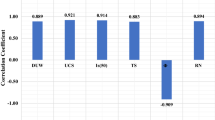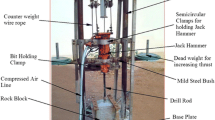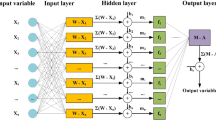Abstract
Determining properties of rocks in rock mechanics/engineering applications such as underground tunnelling, slope stability, foundations, dam design and rock blasting is often difficult due to the requirements of high quality of core rock samples and accurate test apparatus. Prediction of the geomechanical properties of rock material has been an area of interest for rock mechanics for several years now. Nowadays, soft computing methods are used as a powerful tool to estimate the rock properties, cost and duration of the project. This has led to a lack of necessity to develop a model to predict rock properties in the field of rock mechanics. ANN (artificial neural network) models were developed to predict geomechanical properties of the sedimentary rock types using dominant frequencies of an acoustic signal during rock drilling operations. A set of experimental drilling operations test conditions around 875 were used as input parameters including drill bit spindle speeds (rpm), drill bit penetration rates (mm/min), drill bit diameters (mm) and dominant frequencies of the acoustic signal (Hz). The response (output) was uniaxial compressive strength (UCS), Brazilian tensile strength (BTS), density (\(\rho \)) and abrasivity (%). The developed models were checked using various performance indices. The results from the analysis show that the suggested ANN model approach is efficient, fits the data and accurately reflects the experimental results. The ANN models predicted physico-mechanical rock properties through the dominant frequency of acoustic signals during rock drilling operations.










Similar content being viewed by others
References
Abdi Y, Garavand AT, Sahamieh RZ (2018) Prediction of strength parameters of sedimentary rocks using artificial neural networks and regression analysis. Arab J Geosci 11:587
Aka MU, Okeke FN, Ibuot JC, Obiora DN (2018) Geotechnical investigation of near-surface structures using seismic refraction techniques in parts of akwa ibom state, southern nigeria. Model Earth Syst Environ 4(2):451–459
Akbarpour M, Abdideh M (2020) Wellbore stability analysis based on geomechanical modeling using finite element method. Model Earth Syst Environ 6:617–626
Aldeeky H, AlHattamleh O (2018) Prediction of engineering properties of basalt rock in jordan using ultrasonic pulse velocity test. Geotech Geol Eng 36(6):3511–3525
Ardestani EA, Davarpanah A, Zargar G, Mirshekari B (2019) Mathematical modeling of formation damage effect during underbalanced drilling operations. Model Earth Syst Environ 5(4):1651–1661
Barzegar R, Sattarpour M, Nikudel MR, Moghaddam AA (2016) Comparative evaluation of artificial intelligence models for prediction of uniaxial compressive strength of travertine rocks, case study: Azarshahr area, NW Iran. Model Earth Syst Environ 2(2):76
Bhatnagar A, Khandelwal M (2012) An intelligent approach to evaluate drilling performance. Neural Comput Appl 21(4):763–770
Cao QJ, Wiercigroch M, Pavlovskaia E, Yang SP (2010) Bifurcations and the penetrating rate analysis of a model for percussive drilling. Acta Mech Sin 26(3):467–475
Dehghan S, Sattari GH, Chelgani SC, Aliabadi MA (2010) Prediction of uniaxial compressive strength and modulus of elasticity for travertine samples using regression and artificial neural networks. Min Sci Technol 20(1):41–46
Dehkordi MS, Lazemi HA, SaeedModaghegh HR (2019) Estimation of the drop modulus using the brittleness index of intact rock and geological strength index of rock mass, case studies: Nosoud and Zagros tunnels in Iran. Model Earth Syst Environ 5(2):479–492
Delibalta MS, Kahraman S, Comakli R (2015) The usability of noise level from rock cutting for the prediction of physic–mechanical properties of rocks. Fluct Noise Lett 14(1):1550006
Dolui G, Chatterjee S, Chatterjee ND (2016) Geophysical and geochemical alteration of rocks in granitic profiles during intense weathering in southern Purulia district, West Bengal. India Model Earth Syst Environ 2(3):132
Ekanem AM, George NJ, Thomas JE, Ekpenyong NE (2020) Seismic modelling study of CO 2 effects on P-wave amplitude. Modeling Earth Systems and Environment 00904–9
Fajana AO (2020) Geohazard characterization of subsurface materials using integrated geophysical methods for post foundation studies: a case study. Modeling Earth Systems and Environment 1–13
Fatoba JO, Eluwole AB, Sanuade OA, Hammed OS, Igboama WN, Amosun JO (2020) Geophysical and geochemical assessments of the environmental impact of Abule-Egba landfill, southwestern Nigeria. Modeling Earth Systems and Environment, pp 1–7
Finol J, Guo YK, **g XD (2001) A rule based fuzzy model for the prediction of petro physical rock parameters. J Pet Sci Eng 29:97–113
Flegner P, Kačur J, Durdán M, Leššo I, Laciak M (2014) Measurement and processing of vibro-acoustic signal from the process of rock disintegration by rotary drilling. Measurement 56:178–193
Flegner P, Kačur J, Durdán M, Laciak M (2019) Processing a measured vibroacoustic signal for rock type recognition in rotary drilling technology. Measurement 134:451–467
Forouharmajd F, Mohammadi Z, Ahmadvand M, Forouharmajd F (2015) Sound pressure level tools design used in occupational health by means of labview software. Int J Environ Health Eng 4(1):1–6
Ghaboussi J, Garrett JH Jr, Wu X (1991) Knowledge-based modeling of material behavior with neural networks. J Eng Mech 117(1):132–153
Ghosh PK, Bandyopadhyay S, Jana NC (2016) Map** of groundwater potential zones in hard rock terrain using geoinformatics: a case of kumari watershed in western part of West Bengal. Model Earth Syst Environ 2(1):1
Gokceoglu C (2002) A fuzzy triangular chart to predict the uniaxial compressive strength of the Ankara agglomerates from their petrographic composition. Eng Geol 66:39–51
Gradl C, Eusteslll AW, Thonhauser G (2007) An analysis of noise characteristics of drill bits. J Energy Resour Technol 134(013103):1–6
Handhal AM (2016) Prediction of reservoir permeability from porosity measurements for the upper sandstone member of Zubair Formation in Super-Giant South Rumila oil field, southern Iraq, using M5P decision tress and adaptive neuro-fuzzy inference system (ANFIS): a comparative study. Model Earth Syst Environ 2(3):111
Hardy HR (1972) Application of acoustic emission techniques to rock mechanics research acoustic emission ASTM STP 505. American Society for Testing and Materials, pp 41–83
Hassanpour J, Rostami J, Zhao J (2011) A new hard rock TBM performance prediction model for project planning. Tunn Undergr Space Technol 26(5):595–603
Haykin S (1998) Neural networks: a comprehensive foundation. Prentice Hall PTR, Upper Saddle River, NJ, USA
Jamshidi A (2018) Prediction of TBM penetration rate from brittleness indexes using multiple regression analysis. Model Earth Syst Environ 4(1):383–394
Kahraman S, Delibalta MS, Comakli R (2013) Noise level measurement test to predict the abrasion resistance of rock aggregates. Fluct Noise Lett 12(4):1350021
Kivade SB, Murthy ChSN, Vardhan H (2015) ANN models for prediction of sound and penetration rate in percussive drilling. J Inst Eng 96(2):93–103
Krepelka F, Futo J (2007) Acoustics aspects of technological process in the rock identification. Acta montanistica slovaca 12(1):25–28
Krúpa V, Kruľáková M, Lazarová E, Labaš M, Feriančiková K, Ivaničová L (2018) Measurement, modeling and prediction of penetration depth in rotary drilling of rocks. Measurement 117:165–175
Kumar BR, Vardhan H, Govindaraj M, Vijay GS (2013) Regression analysis and ANN models to predict rock properties from sound levels produced during drilling. Int J Rock Mech Min Sci 58:61–72
Kumar SV, Kunar BM, Murthy ChSN (2018a) Experimental investigation and statistical analysis of operational parameters on temperature rise in rock drilling. Int J Heat Technol 36(4):1174–1180
Kumar SV, Murthy ChSN, Kunar BM (2018b) Effect of thermal response on physical properties during drilling operations a case study. Mater Today 5(2):7404–7409
Kumar NH, Choudhary RP, Murthy CS (2019a) Evolution of the probability distribution function of shovel–dumper combination in open cast limestone mine using RWB and ANN: a case study. Model Earth Syst Environ 5(4):1607–1613
Kumar CHV, Vardhan H, Murthy CS (2019b) Quantification of rock properties using frequency analysis during diamond core drilling operations. J Inst Eng 100(1):67–81
Kumar CHV, Vardhan H, Murthy CS, Karmakar NC (2019c) Estimating rock properties using sound signal dominant frequencies during diamond core drilling operations. J Rock Mech Geotech Eng 11(4):850–859
Kumar SV, Kunar BM, Murthy ChSN (2019d) Temperature measurement during rotary drilling of rocks a statistical approach learning and analytics in intelligent systems. Springer Book Series 2:303–309
Kumar CHV, Vardhan H, Murthy CS (2020a) Multiple regression model for prediction of rock properties using acoustic frequency during core drilling operations. Geomech Geoeng 15(4):297–312
Kumar CHV, Murthy CS, Vardhan H (2020b) Prediction of specific energy using dominant frequency of acoustics produced during diamond core drilling operations. AIP Conf Proc 2204(1):040003 (AIP Publishing LLC)
Kumar SV, Kunar BM, Murthy ChSN, Ramesh MR (2020c) Measurement of bit-rock interface temperature and wear rate of the tungsten carbide drill bit during rotary drilling. Friction 8(6):1073–1082
Kumar SV, Kunar BM, Murthy ChSN (2020d) ANN model for prediction of bit-rock interface temperature during rotary drilling of limestone using embedded thermocouple technique. J Therm Anal Calorim 139(3):2273–2282
Liao M, Liu Y, Chávez JP, ChongWiercigroch ASM (2018) Dynamics of vibro-impact drilling with linear and nonlinear rock models. Int J Mech Sci 146:200–210
Liu S, Li X, Li Z, Chen P, Yang X, Liu Y (2019) Energy distribution and fractal characterization of acoustic emission (AE) during coal deformation and fracturing. Measurement 136:122–131
Madhubabu N, Singh PK, Kainthola A, Mahanta B, Tripathy A, Singh TN (2016) Prediction of compressive strength and elastic modulus of carbonate rocks. Measurement 88:202–213
McNally GH (1990) The prediction of geotechnical rock properties from sonic and neutron logs. Aus Soc Explor Geophys 21(1/2):65–71
Meireles MR, Almeida PE, Simões MG (2003) A comprehensive review for industrial applicability of artificial neural networks. IEEE Trans Industr Electron 50(3):585–601
Meulenkamp F, Grima MA (1999) Application of neural networks for the prediction of the unconfined compressive strength (UCS) from Equotip hardness. Int J Rock Mech Min Sci 36(1):29–39
Miklusova V, Usalova L, Ivanicova L, Krepelka F (2006) Acoustic signal - new feature in monitoring of rock disintegration process. Contrib Geophys Geod 36:125–133
Mohammadreza AG, Yousef AG (2019) Modelling soil compaction of agricultural soils using fuzzy logic approach and adaptive neuro-fuzzy inference system (ANFIS) approaches. Model Earth Syst Environ 5(1):13–20
Momeni E, Armaghani DJ, Hajihassani M, Amin MFM (2015) Prediction of uniaxial compressive strength of rock samples using hybrid particle swarm optimization-based artificial neural networks. Measurement 60:50–63
Narayana CRL, Tripathi AK, Pal SK (2019) Estimation of rock strength properties using selected mechanical parameters obtained during the rotary drilling. J Inst Eng 100(2):177–186
Narayana CRL, Tripathi AK, Pal SK (2020a) Rock strength characterization using measurement while drilling technique. Indian Geotech J 50:994–1005
Narayana CRL, Tripathi AK, Pal SK (2020b) Prediction of mechanical properties of sedimentary type rocks using rotary drilling parameters. Geotech Geol Eng 38:4863–4876
Obert L. (1941) Use of sub audible noises for prediction of rock bursts—Part I. U.S. Bureau of Mines R.I.3555.
Obert L, Duvall W (1942) Use of sub audible noises for prediction of rock bursts—Part II.U.S. Bureau of Mines R.I.3654
Ocak I, Seker SE (2012) Estimation of elastic modulus of intact rocks by artificial neural network. Rock Mech Rock Eng 45(6):1047–1054
Ohaegbuchu HE, Igboekwe MU (2016) Determination of subsurface rock properties from AVO analysis in konga oil field of the niger delta, southeastern nigeria. Model Earth Syst Environ 2(3):124
Okon AN, Adewole SE, Uguma EM (2020) Artificial neural network model for reservoir petrophysical properties: porosity, permeability and water saturation prediction. Modeling Earth Systems and Environment, pp 1–18
Omar H, Ahmad J, Nahazanan H, Mohammed TA, Yusoff ZM (2018) Measurement and simulation of diametrical and axial indirect tensile tests for weak rocks. Measurement 127:299–307
Rafavich F, Kendall CH, Todd TP (1984) The relationship between acoustic properties and the petrographic character of carbonate rocks. Geophysics 49(10):1622–1636
Raj AS, Oliver DH, Srinivas Y, Viswanath J (2016) Wavelet denoising algorithm to refine noisy geoelectrical data for versatile inversion. Model Earth Syst Environ 2(1):36
Raj AS, Srinivas Y, Damodharan R, Oliver DH, Viswanath J (2020) Presentation of neurofuzzy optimally weighted sampling model for geoelectrical data inversion. Modeling Earth Systems and Environment, pp. 1–12
Rastegarnia A, Teshnizi ES, Hosseini S, Shamsi H, Etemadifar M (2018) Estimation of punch strength index and static properties of sedimentary rocks using neural networks in south west of Iran. Measurement 128:464–478
Rumelhart DE, McClelland JL (1986) PDP Research Group. Parallel distributed processing: Exploration in the microstructure of cognition 1
Salehin S, Hadavandi E, Chelgani SC (2020) Exploring relationships between mechanical properties of marl core samples by a coupling of mutual information and predictive ensemble model. Model Earth Syst Environ 6(1):575–583
Salimia A, Moormanna C, Singhb TN, Jainc P (2015) TBM performance prediction in rock tunneling using various artificial intelligence algorithms. In Proceeding 11th Iranian and 2nd Regional Conference Tunnels and the Future”, Stuttgart, Germany
Sarkar K, Tiwary A, Singh TN (2010) Estimation of strength parameters of rock using artificial neural networks. Bull Eng Geol Env 69(4):599–606
Shahri AA, Larsson S, Renkel C (2020) Artificial intelligence models to generate visualized bedrock level: a case study in Sweden. Model Earth Syst Environ 6:1509–1528
Shreedharan S, Hegde C, Sharma S, Vardhan H (2014) Acoustic fingerprinting for rock identification during drilling. Int J Min Miner Eng 5(2):89–105
Simpson PK (1990) Artificial neural systems: foundations, paradigms, applications, and implementations. Pergamon.
Singh VK, Singh D, Singh TN (2001) Prediction of strength properties of some schistose rocks from petrographic properties using artificial neural networks. Int J Rock Mech Min Sci 38(2):269–284
Singh TN, Kanchan R, Verma AK, Singh S (2003) An intelligent approach for prediction of triaxial properties using unconfined uniaxial strength. Min Eng J 5(4):12–16
Sonmez H, Gokceoglu C, Nefeslioglu HA, Kayabasi A (2006) Estimation of rock modulus: for intact rocks with an artificial neural network and for rock masses with a new empirical equation. Int J Rock Mech Min Sci 43(2):224–235
Talkhablou M, Kianpour M, Aghda SF (2019) ArcGIS fuzzy modeling to assess the relationship between seismic wave velocity and electrical resistivity with limestone mass quality (case study: Asmari Formation, southwest Iran). Model Earth Syst Environ 5(3):1025–1035
Teymen A (2019) Estimation of Los Angeles abrasion resistance of igneous rocks from mechanical aggregate properties. Bull Eng Geol Env 78(2):837–846
Tiryaki B (2008a) Application of artificial neural networks for predicting the cuttability of rocks by drag tools. Tunn Undergr Space Technol 23(3):273–280
Tiryaki B (2008b) Predicting intact rock strength for mechanical excavation using multivariate statistics, artificial neural networks, and regression trees. Eng Geol 99(1–2):51–60
Tiryaki B, Ayhan M, Hekimoglu OZ (2001) A new computer program for cutting head design of roadheaders and drum shearers. In 17th International Mining Congress and Exhibition of Turkey–IMCET 655–662
Tripathy A, Singh TN, Kundu J (2015) Prediction of abrasiveness index of some Indian rocks using soft computing methods. Measurement 68:302–309
Vardhan H, Murthy ChSN (2007) An experimental investigation of jack hammer drill noise with special emphasis on drilling in rocks of different compressive strengths. Noise Control Eng J 55(3):282–293
Vardhan H, Adhikari CR, Govindaraj M (2009) Estimating rock properties using sound levels produced during drilling. Int J Rock Mech Min Sci 46:604–612
Yilma M, Kiflie Z, Windsperger A, Gessese N (2018) Application of artificial neural network in water quality index prediction: a case study in little akaki river, addis ababa, ethiopia. Model Earth Syst Environ 4(1):175–187
Yilmaz I (2009) Prediction of the strength and elasticity modulus of gypsum using multiple regression, ANN, and ANFIS models. Int J Rock Mech Min Sci 46:803–810
Yilmaz I (2010) Comparison of landslide susceptibility map** methodologies for Koyulhisar, Turkey: conditional probability, logistic regression, artificial neural networks, and support vector machine. Environ Earth Sci 61(4):821–836
Yilmaz I, Kaynar O (2011) Multiple regression, ANN (RBF, MLP) and ANFIS models for prediction of swell potential of clayey soils. Expert Syst Appl 38(5):5958–5966
Yılmaz I, Sendır H (2002) Correlation of Schmidt hardness with unconfined compressive strength and Young’s modulus in gypsum from Sivas (Turkey). Eng Geol 66(3–4):211–219
Yılmaz I, Yuksek AG (2008) An example of artificial neural network (ANN) application for indirect estimation of rock parameters. Rock Mech Rock Eng 41(5):781–795
Zborovjan M (2001) Identification of minerals during drilling process via acoustic signal. Metallurgy and Foundry Krakow Poland 26 (4)
Zborovjan M (2002) Identification of Minerals from Sound during Drilling. Semestral Project TU-Kosice, Poland
Zborovjan M, Lesso I, Dorcak L (2003) Acoustic identification of rocks during drilling process. Acta Montanistica Slovaca 8(4):191–193
Zorlu K, Gokceoglu C, Ocakoglu F, Nefeslioglu HA, Acikalin S (2008) Prediction of uniaxial compressive strength of sandstones using petrography-based models. Eng Geol 96(3–4):141–158
Author information
Authors and Affiliations
Corresponding author
Ethics declarations
Conflict of interest
The authors wish to confirm that there are no known conflicts of interest associated with this publication and there has been no significant financial support for this work that could have influenced its outcome.
Additional information
Publisher's Note
Springer Nature remains neutral with regard to jurisdictional claims in published maps and institutional affiliations.
Rights and permissions
About this article
Cite this article
Kumar, C.V., Vardhan, H. & Murthy, C.S.N. Artificial neural network for prediction of rock properties using acoustic frequencies recorded during rock drilling operations. Model. Earth Syst. Environ. 8, 141–161 (2022). https://doi.org/10.1007/s40808-021-01103-w
Received:
Accepted:
Published:
Issue Date:
DOI: https://doi.org/10.1007/s40808-021-01103-w




